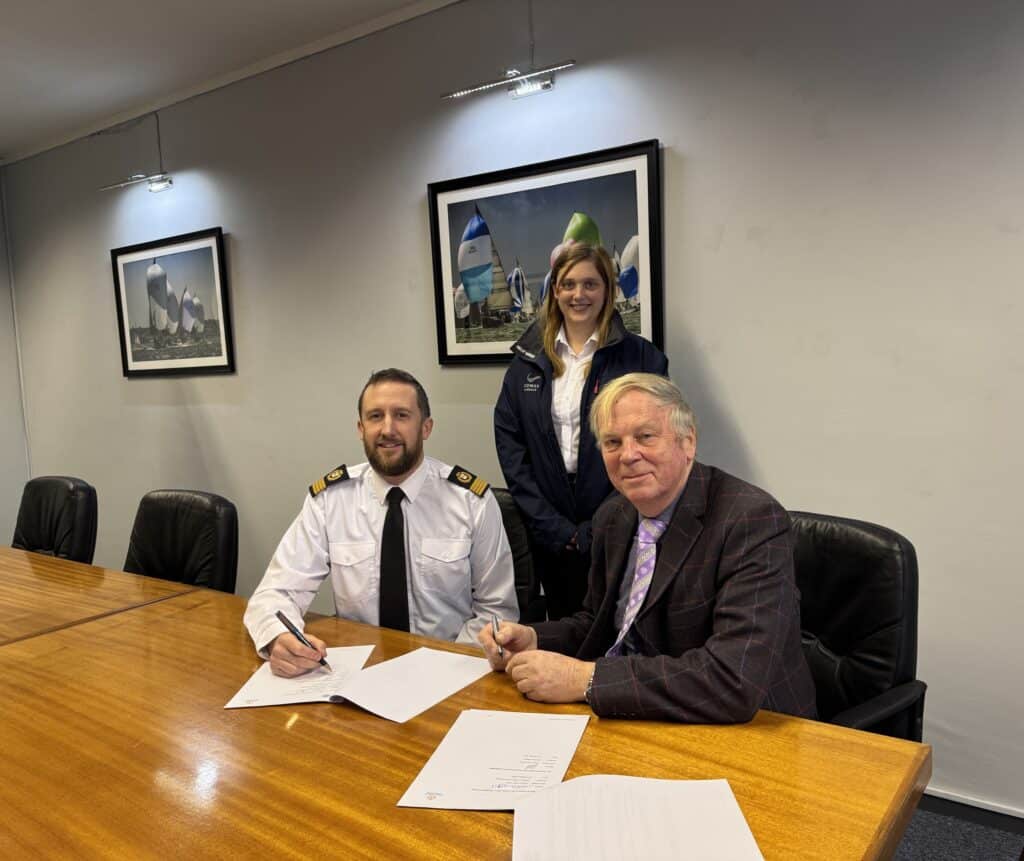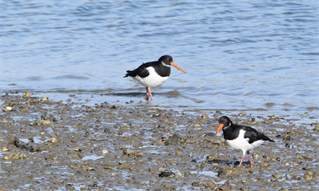
As winter approaches, it may be a quieter time for sailing but it is a very busy and important time for the estuary’s wildlife. This time of year sees the arrival of our overwintering birds as well as those that stop off to feed and rest whilst on their long journeys.
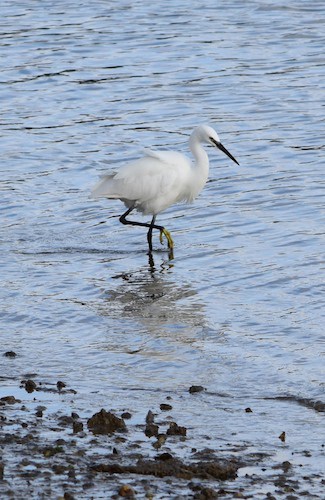 The birds that feed here throughout the winter are building up the vital energy supplies that they will need to power their onward migration at the end of the season. Each time we startle them into flight they lose some of these essential reserves and their chances of surviving diminish. If you are out and about over the autumn and winter months, see how many of our visitors you can spot, but please do your best not to disturb them.
The birds that feed here throughout the winter are building up the vital energy supplies that they will need to power their onward migration at the end of the season. Each time we startle them into flight they lose some of these essential reserves and their chances of surviving diminish. If you are out and about over the autumn and winter months, see how many of our visitors you can spot, but please do your best not to disturb them.
From October to March, groups of overwintering waterbirds such as Black-tailed Godwit, Wigeon and Teal depend on the estuary’s mud and saltmarsh for feeding, roosting and refuge. The most noticeable of the winter visitors are probably the noisy flocks of Dark-bellied brent geese. Dozens of these pretty, compact black and white geese feed on the green algae and roost on the saltmarsh and nearby fields at high water. The saltmarsh is an important coastal habitat made up of plants that are specially adapted to the salt water and tidal conditions. They contain nutrients that support a range of special invertebrates and act as nursery areas for fish and crustaceans which all provide food for the many species of birds.
The Medina’s mudflats are also teeming with invertebrate life including worms, crustaceans and molluscs. The tiny Laver Spire Shell Hydrobia ulvae is just four and a half millimetres long but is present in such large numbers that it provides food for hundreds of birds. One of the visitors that eat the tiny snail is the Teal, a small, beautifully marked duck that you might see on the water or catch a glimpse of the quick green flash of its wings in flight. Other visitors include the Ringed plover, a small wading bird with a smart black and white pattern on its head and a short and orange bill with a black-tip. They are often seen with the flocks of small brown Dunlin that skitter along the shoreline searching for food. You might also spot the aptly-named Redshank, with its long red legs, as it probes the mud for molluscs.
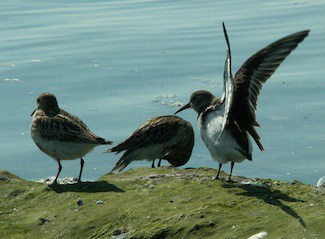 Our resident Cormorants can often be seen searching for fish and in winter they are joined by Little grebes, Red-breasted mergansers and Goldeneye. The Little grebes are sometimes quite difficult to spot as they disappear under water in search of prey and pop back up some way off. Also resident are Oystercatchers, Curlew and Little egret. The black and white Oystercatcher, with its bright orange legs and bill, is unmistakable as it searches for cockles along the shore and has a distinctive single note call when in flight. The Curlew also has a distinctive and evocative call and is easily recognised by its long, curved beak. Look out too for the bright white of the Little egret as it picks its way carefully along the water’s edge in search of food. A member of the heron family with bright yellow feet, this distinctive bird has increased in number in the estuary over the last 10 years due to our warmer weather.
Our resident Cormorants can often be seen searching for fish and in winter they are joined by Little grebes, Red-breasted mergansers and Goldeneye. The Little grebes are sometimes quite difficult to spot as they disappear under water in search of prey and pop back up some way off. Also resident are Oystercatchers, Curlew and Little egret. The black and white Oystercatcher, with its bright orange legs and bill, is unmistakable as it searches for cockles along the shore and has a distinctive single note call when in flight. The Curlew also has a distinctive and evocative call and is easily recognised by its long, curved beak. Look out too for the bright white of the Little egret as it picks its way carefully along the water’s edge in search of food. A member of the heron family with bright yellow feet, this distinctive bird has increased in number in the estuary over the last 10 years due to our warmer weather.
The Medina is home to some of Europe’s rarest and most vulnerable migratory birds. Its mudflats, saltmarsh and surrounding land forms part of a network of wetland sites around the Solent that has the highest level of European nature conservation protection. By ensuring a balance between our activities and the conservation and enhancement of our natural resources we will be able to continue to welcome our special winter visitors for many years to come.
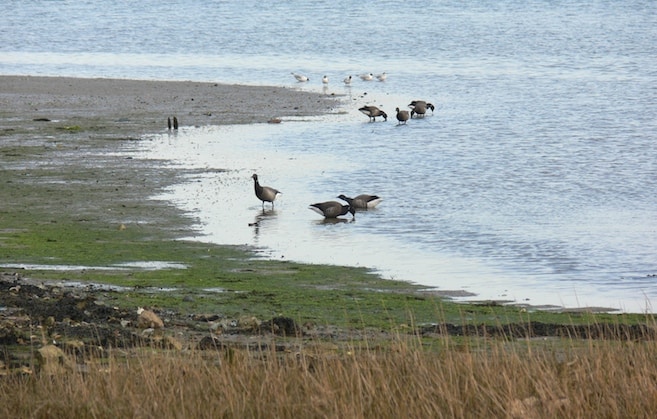
• Read more about the River Medina in our Environment section
• View more photos on Flickr of the River Medina

 The birds that feed here throughout the winter are building up the vital energy supplies that they will need to power their onward migration at the end of the season. Each time we startle them into flight they lose some of these essential reserves and their chances of surviving diminish. If you are out and about over the autumn and winter months, see how many of our visitors you can spot, but please do your best not to disturb them.
The birds that feed here throughout the winter are building up the vital energy supplies that they will need to power their onward migration at the end of the season. Each time we startle them into flight they lose some of these essential reserves and their chances of surviving diminish. If you are out and about over the autumn and winter months, see how many of our visitors you can spot, but please do your best not to disturb them.  Our resident Cormorants can often be seen searching for fish and in winter they are joined by Little grebes, Red-breasted mergansers and Goldeneye. The Little grebes are sometimes quite difficult to spot as they disappear under water in search of prey and pop back up some way off. Also resident are Oystercatchers, Curlew and Little egret. The black and white Oystercatcher, with its bright orange legs and bill, is unmistakable as it searches for cockles along the shore and has a distinctive single note call when in flight. The Curlew also has a distinctive and evocative call and is easily recognised by its long, curved beak. Look out too for the bright white of the Little egret as it picks its way carefully along the water’s edge in search of food. A member of the heron family with bright yellow feet, this distinctive bird has increased in number in the estuary over the last 10 years due to our warmer weather.
Our resident Cormorants can often be seen searching for fish and in winter they are joined by Little grebes, Red-breasted mergansers and Goldeneye. The Little grebes are sometimes quite difficult to spot as they disappear under water in search of prey and pop back up some way off. Also resident are Oystercatchers, Curlew and Little egret. The black and white Oystercatcher, with its bright orange legs and bill, is unmistakable as it searches for cockles along the shore and has a distinctive single note call when in flight. The Curlew also has a distinctive and evocative call and is easily recognised by its long, curved beak. Look out too for the bright white of the Little egret as it picks its way carefully along the water’s edge in search of food. A member of the heron family with bright yellow feet, this distinctive bird has increased in number in the estuary over the last 10 years due to our warmer weather.
